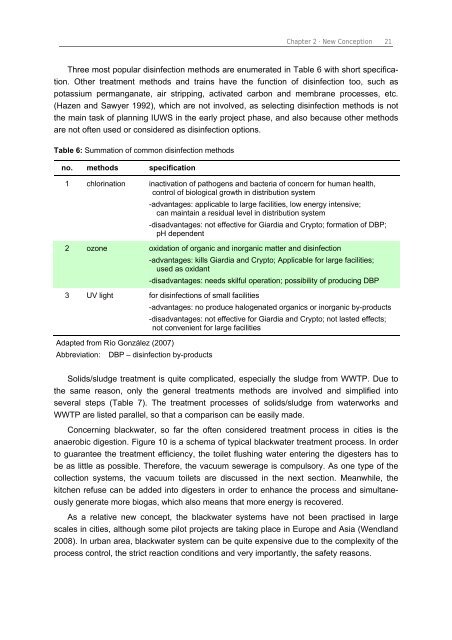Chapter 3 Decision Support Model (IUWS-DSM) - Tubdok
Chapter 3 Decision Support Model (IUWS-DSM) - Tubdok
Chapter 3 Decision Support Model (IUWS-DSM) - Tubdok
You also want an ePaper? Increase the reach of your titles
YUMPU automatically turns print PDFs into web optimized ePapers that Google loves.
<strong>Chapter</strong> 2 · New Conception 21<br />
Three most popular disinfection methods are enumerated in Table 6 with short specification.<br />
Other treatment methods and trains have the function of disinfection too, such as<br />
potassium permanganate, air stripping, activated carbon and membrane processes, etc.<br />
(Hazen and Sawyer 1992), which are not involved, as selecting disinfection methods is not<br />
the main task of planning <strong>IUWS</strong> in the early project phase, and also because other methods<br />
are not often used or considered as disinfection options.<br />
Table 6: Summation of common disinfection methods<br />
no. methods specification<br />
1 chlorination<br />
2 ozone<br />
inactivation of pathogens and bacteria of concern for human health,<br />
control of biological growth in distribution system<br />
-advantages: applicable to large facilities, low energy intensive;<br />
can maintain a residual level in distribution system<br />
-disadvantages: not effective for Giardia and Crypto; formation of DBP;<br />
pH dependent<br />
oxidation of organic and inorganic matter and disinfection<br />
-advantages: kills Giardia and Crypto; Applicable for large facilities;<br />
used as oxidant<br />
-disadvantages: needs skilful operation; possibility of producing DBP<br />
3 UV light for disinfections of small facilities<br />
-advantages: no produce halogenated organics or inorganic by-products<br />
-disadvantages: not effective for Giardia and Crypto; not lasted effects;<br />
not convenient for large facilities<br />
Adapted from Río González (2007)<br />
Abbreviation: DBP – disinfection by-products<br />
Solids/sludge treatment is quite complicated, especially the sludge from WWTP. Due to<br />
the same reason, only the general treatments methods are involved and simplified into<br />
several steps (Table 7). The treatment processes of solids/sludge from waterworks and<br />
WWTP are listed parallel, so that a comparison can be easily made.<br />
Concerning blackwater, so far the often considered treatment process in cities is the<br />
anaerobic digestion. Figure 10 is a schema of typical blackwater treatment process. In order<br />
to guarantee the treatment efficiency, the toilet flushing water entering the digesters has to<br />
be as little as possible. Therefore, the vacuum sewerage is compulsory. As one type of the<br />
collection systems, the vacuum toilets are discussed in the next section. Meanwhile, the<br />
kitchen refuse can be added into digesters in order to enhance the process and simultaneously<br />
generate more biogas, which also means that more energy is recovered.<br />
As a relative new concept, the blackwater systems have not been practised in large<br />
scales in cities, although some pilot projects are taking place in Europe and Asia (Wendland<br />
2008). In urban area, blackwater system can be quite expensive due to the complexity of the<br />
process control, the strict reaction conditions and very importantly, the safety reasons.

















